Sierra Designs Flex Capacitor Overview
Great Scott! Marty, they’ve taken my Flux Capacitor and transformed it into a lightweight flex-suspension system for this backpack, the Sierra Designs Flex Capacitor. Ditch the DeLorean and grab your gear, boy. Where we’re going, we don’t need roads.
Designed with the help of notable ultralight backpacker Andrew Skurka (and less notable make-believe mad scientist Doc Brown), the Sierra Designs Flex Capacitor backpack features an exterior gusset system that allows you to adjust the pack’s volume between 40 and 60 liters without sacrificing load-carrying performance. Inside, the Y-FLEX suspension supports heavy loads without the type of stiff frame found in other, more burly backpacks, and manages to remain ultralight.
Despite innovation and minimal weight, the Flex Capacitor doesn’t cut corners. This pack comes featured with six exterior pockets, a range of hip belt sizing options, and can be purchased for under $200.
All of these factors combined have led us to give the Sierra Designs Flex Capacitor our Budget Pick award for the Ultralight Backpacker.
Sierra Designs Flex Capacitor Star Rating
- Comfort
- Durability
- Packability
- Fit and Adjustability
Summary
The Sierra Design Flex Capacitor has been cleverly designed with the modern ultralight backpacker in mind. Adjustable volume and the option for heavy loads allow a seamless transition to ultralight, and it has all the features you need with very little you don’t.
At roughly two pounds, 10 ounces, the Flex Capacitor is on par with entry level ultralight backpacks. It has a frame, and works best with the frame, so it can’t go much lower than this weight, which some hardcore ultralighters won’t like. If you’re looking for more weight-shedding ability (and less heavy-capable hauling) in the same price range, we suggest the Granite Gear Crown2 60. We gave the old version of the Crown2 60 (called the Crown V.C. 60) our Budget Pick in 2016, and the new version is even better. In the end we like the Flex Capacitor more because it can haul heavier loads if need be, which is optimal for new ultralight backpackers.
Keep reading the full Sierra Designs Flex Capacitor review to see why we think it rocks as hard as Marty shredding the axe to Johnny B. Goode, and check out our comprehensive backpack guide.
Update: We tested the Sierra Designs Flex Capacitor in 2017, and it has not received any major updates since.
Sierra Designs Flex Capacitor Specifications
| Feature Type | Feature Specs | What This Means |
| Weight | 2 lbs 10 oz. (1.19 kg) | Any backpack that’s decently under three pounds and can hold up to 60 liters is ultralight in our book. You can get lighter than this, but not for a fully featured, load-carrying trekking pack. |
| Capacity | 40-60L | The Flex Capacitor’s claim to fame is that it can fit adjust from 40-60 liters. It has a fancy strap system that tightens the load to dial in exactly what you need. Learn more about backpack capacity in our Guide. |
| Frame | Internal, Removable, Y-FLEX suspension | The Y-FLEX suspension is technically removable, but we don’t recommend it. It’s super light and can haul up to 50 pounds comfortably. |
| Frame Material | DAC Pressfit Aluminum | Ultralight, ultra-strong. This is what high-end backpacking tent poles are made out of, and do an excellent job in this pack. |
| Hip Belt Fit | 29-32 in. (74-81 cm) for SM/MD | The Flex Capacitor has four hip belt sizes and you pick the one you want when ordering. They fit anything from less than 29 inches all the way up to more than 35 inches. Be sure to know your measurement and pick the right one when buying! Learn more about backpack hip belts and how to measure in our Guide. |
| Torso Fit | Not Adjustable. 16-19 in. (40-48 cm) for S/M, 18-21 in. (45-53 cm) for M/L | The torso can’t be adjusted dramatically, but it does fit a range. Order either the S/M pack for smaller torsos, or a M/L pack for larger torsos. This will fit most people. To learn more about backpack torso measurement and adjustable torsos see our Guide. |
| Number of Exterior Pockets | 6 | While the Flex Capacitor does not have much internal organization or many pockets, the six external pockets it does have are well designed. Two hip belt pockets, two side water bottle pockets, one shoulder strap pocket, and one zippered lid pocket. |
| Sleeping Bag Compartment | No | The Flex Capacitor is one long chute and can only be accessed from the top. |
| Hydration Sleeve | Yes | Standard area for storing a hydration reservoir inside the pack. |
| Main Pack Access | Zippered | This pack has a top lid that opens via zipper, not drawstring (which is more standard). It’s one long chute, so organize well. |
| Detachable Top Lid | No | It has a zippered top lid, but it’s not detachable at all. |
| Trekking Pole/Ice Axe Loops | Yes | The compression straps on the exterior serve to secure trekking poles or ice axes, and there are two slots at the bottom of the pack to hold them. |
| Materials | 100D Nylon-Poly Ripstop, 420D Nylon Oxford | Solid material. Will stand up to abuse. |
| Load Range | 35-50 lbs. (16- 22.6 kg) | For an ultralight backpack the Flex Capacitor can hold a surprising amount of weight. Tested at 40-50 pounds on trips, it’s very capable of these listed weights. |
| Other Versions | N/A | Sierra Designs only makes the one version of this backpack pack, and it adjusts from 40 to 60 liters depending on what you need. |
| Warranty | Limited Lifetime Warranty | Sierra Designs backpacks are warranted to the original owner against manufacturing defects in materials and workmanship for the lifetime of the product. Does not include normal wear and tear. Good reputation, so get in touch if something fails. |
| Retail Price | $199.95 | An excellent pack for under $200. |
Gear Review of Sierra Designs Flex Capacitor
Origins: Easing You In
I’m not an extreme ultralight backpacker, although I’m leaning into it more with each and every trip I take. There’s something refreshing about shedding unnecessary equipment, as if each ounce left at home is another ounce of freedom gained on the trail.
In preparing for a week-long trek into the Northern California Trinity Wilderness I swapped out my tried-and-true 60 liter Deuter Futura backpack for the newly-released Flex Capacitor. In doing so I had to give up some organizational versatility — the Futura has an endless array of zippers and pockets, while the Flex Capacitor mostly has just one long chute to stuff all your gear in. But I also cut off over two pounds of weight. Taking a step toward ultralight involves a little give and take. Mostly take, as in take out.
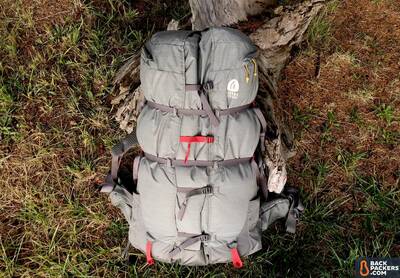
The Flex Capacitor full up. Everything has to fit down the single chute, and then you squeeze those straps to get it tight.
Because of the differences in design, I had to pack my gear into the Flex Capacitor with a different mindset than my usual routine. This took a few attempts. Sure enough, I found a spot for all of my equipment eventually.
For this journey I had loaded the bag with over 40 pounds of gear, food, and a few liters of water to cover my first dry miles, which is more than most “ultralight” excursions. My base pack weight (the weight of my gear without considering food, water, and the clothes I was wearing) was about 14 pounds. I have overestimated my food needs ever since the one time I ran out of food in the Sierra Nevada mountains, but that’s another story.
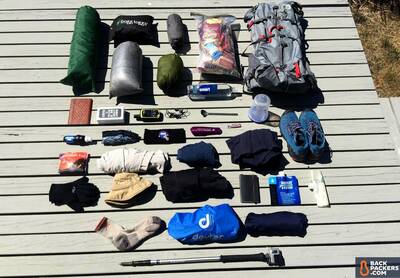
The basic packing list. Yes, most of this fit in the Flex Capacitor, with room to spare.
On this trip I didn’t fill the pack’s 60 liters of space to capacity, so I constricted the gusset system to make sure everything was centered and balanced on my back. Compression straps locked in, the Flex Capacitor was so compact and light that it felt perfectly fitted to the amount of gear I took, yet I knew there was more available space if I ever needed it.

Hitting the trail with a locked and loaded Flex Capacitor.
Revelation: The Moment I Knew
It all started with that moment when I first laced down the compression straps. It was quite a surprise to learn how much of a difference a firmly packed and strapped backpack improved the positioning of weight on my back. Yeesh, try to say that ten times fast.
As the on-trail days passed, I, of course, ate through my food supply. My meal choices aren’t always ultralight (a large stack of sandwiches occupied my LOKSAK OPSAK on this trip, yum!), so as I gobbled my way through my backpack pantry an empty void was left behind.
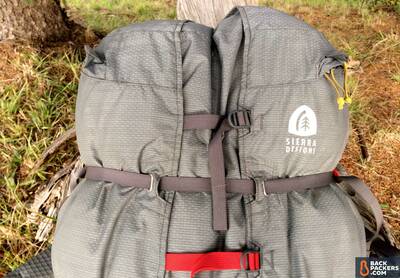
The unique strap system by Sierra Designs allows you to get this pack dialed in to the perfect fit as you eat through your food.
In my Deuter Futura, and other packs I’ve used, this often leads to a floppy pack with a load of dead space in it. Not so with the Flex Capacitor. I kept pulling those compressions straps tighter after every meal, squeezing the pack down smaller and smaller. The bag fit around my gear as well as a balloon fits around the air inside of it, shrinking as the air is released, or, in my case, as the sandwiches were devoured.
This ability translates to an always-centered weight. This means you can hike faster, better, and with a lot less awkward shifting as you go through (or fill up) your consumables.
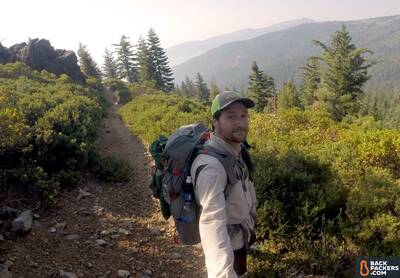
The Flex Capacitor noticeably smaller after a few days on the trail.
Digging Deeper
There are six straps that allow you to adjust the Flex Capacitor’s volume capacity. The four small, centered lateral straps work primarily to lock in the specific size you’re aiming for, while the two larger compression straps wrap around the entire body of the bag to cinch everything down tight. These larger compression straps also offer the utility of strapping down exterior objects, like trekking poles or an ice axe.
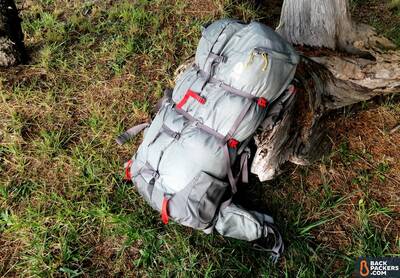
Strap city.
As a pocket-enthusiast my one initial concern with the Flex Capacitor was the seemingly small amount of pocket space, but I was relieved to find that all of the pockets on this pack — there are six in total, all external — were smartly designed.
The two hip belt pockets are easily accessed and large enough to fit your maps and snacks (approximately two hefty sandwiches per pocket — trust me). I slipped a jar of pickles into the other pocket to test for size, and it fit, but this wasn’t a very “ultralight” decision I was making, so I left the crunchy vinegar sticks at home.
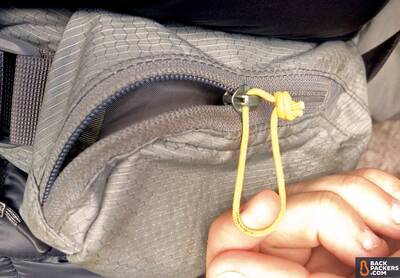
Oversized hip belt pockets allow storage for more items than most packs.
The side water bottle pockets were my favorite because they were easy to reach without needing to take off my pack and deep enough that my Smartwater bottles fit well with plenty of room to spare.

A Smartwater bottle with Sawyer Squeeze easily fits in the backpack’s side pocket. There’s room to spare, and it’s easy to grab while wearing the Flex Capacitor.
The right shoulder strap has a unique, corded pocket at chest level. This is where I kept my iPhone for the duration of my hike because it was ridiculously convenient, allowing me to quickly check my hiking apps and change podcast episodes on the fly. It can also technically fit a small water bottle, but it has to be in the eight ounce range.
The remaining pocket is a small storage compartment located on top of the bag that is ideal for a few quick-grab items like a headlamp, gloves, or any other small items you don’t want to get lost in the vortex of the bag’s main chute.
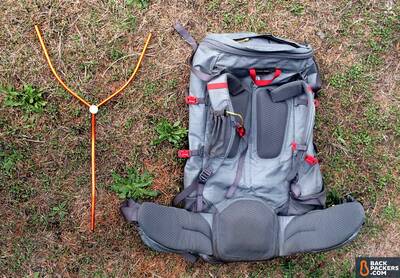
Here you can see the zippered top pocket, which fits a few flat things you need on-hand, the shoulder strap pocket, and the Y-FLEX suspension system.
The Flex Capacitor has a U-shaped zipper lid that opens straight into the primary storage compartment, creating easy access to the pack’s interior without need to unbuckle a strap or undo a rolltop.
Weighing at 2 pounds 10 ounces the Flex Capacitor is strong enough to haul up to 50 pounds of gear. At home I tested the pack at its max weight and it sat comfortably on my hips thanks to the Y-FLEX interior support structure. The supporting frame can be removed if desired, but I wouldn’t recommend it. The couple of ounces you would save in weight is not worth the resulting instability.
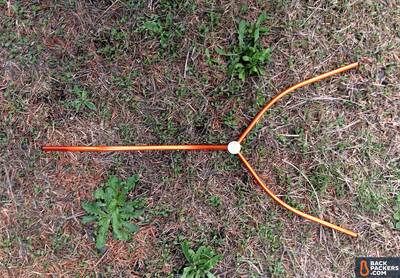
Does it look like the Flux Capacitor to you? Cause it does to us.
Also, note that an ultralight backpack with the ability to carry 50 pounds comfortably is almost unheard of right now, and it makes this an excellent pack for those moving from a heavier setup into the ultralight mindset. There are two packs that are similar in the weight category: the Seek Outside Great Divide, an external frame, mostly ultralight backpack that can haul a huge load; and the Exped Lightning 60.
Comfort
I have a sensitive lower back from an injury years ago. The raised lumbar pad on the Flex Capacitor is extremely well-designed, placing the weight of the pack on my hips in just the right position while also giving me lumbar support. What backpack has ever claimed that it supports your lower back? I swear my back might just be more comfortable wearing this pack than not having one on at all. This is like the La-Z-Boy of ultralight backpacks.
The lumbar pad pairs well with the scapula pads to provide great ventilation and channels dripping sweat down my sides rather than down my butt, preventing chafe.
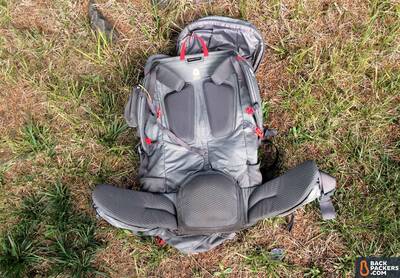
Extreme support comes in the form of firm lumbar and scapula padding on the back. All make for a comfortable carry.
Durability
I can’t say much for extreme long-term durability, though I trust it will hold up well. The 100D poly-ripstop fabric appears to be strong enough for its intended use, and all of the straps, zippers, and buckles seem reliable. After 100 miles of use it still wears like it’s new.
Packability
There is only one access point to the interior chute storage of the Flex Capacitor — and it’s at the very top of the pack. This means you’ll have to pack it smartly with the items you frequently use near the top. Since I only needed them at the end of the day I stuffed my sleeping bag and pad at the bottom to prop up the heavy food bag and my various clothes.
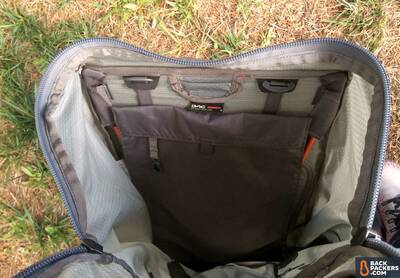
One long chute. Pack well, or you’ll end up dumping the whole thing out to find something.
I then strapped my tent to the outside of the pack using the compression straps. It never slipped from its hold, and having it on the exterior made the interior less cluttered, allowing me to more easily dig inside for what I needed.
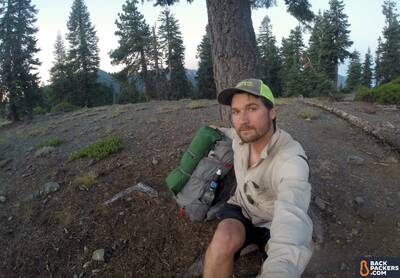
Your use may vary, but the tent strapped to the outside worked well.
The exterior pockets may be enough for some, but I would like more. It’s something I’ve grown used to having. I definitely had a few pack-explosions where I had to empty out all of my gear to find what I was looking for. Yet another reason to shed more gear!
Fit and Adjustability
The unisex Flex Capacitor is available in two torso sizes with four different hip belt options so that you can really dial in your specific size when ordering. The load lifter and hip stabilizer straps make it so you can customize your pack for every journey. My pack fit great all around, and adjusted on the trail as well as any other pack I’ve used.
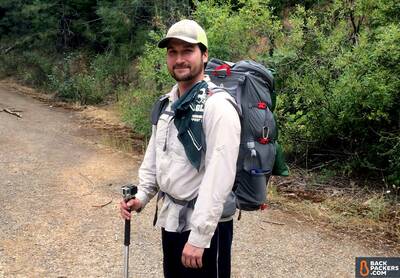
Solid load lifters and a well-fitting hip belt allow for easy carry. Make sure to select the right size for you when ordering.
Grievances
Swinging right back to packability, my one frustration was that I could only access the interior compartment from the one zipper at the top of the bag. You’ll find that to be the case with many modern ultralight backpacks and it’s something I’ll have to adapt to as I continue my ultralight transition. Adding more zippers adds more weight, and the goal is to cut down. That said, a simple zipper that allowed entry to the chute somewhere near the bottom half might be helpful.
It seems that I’ve been spoiled by the convenience of heavier backpacks. Damn you, Deuter! Just kidding, I still love my Futura.
Final Word
Every part of the Sierra Design Flex Capacitor has been cleverly designed with the modern ultralight backpacker in mind. Because of its adjustable volume, this pack works well for those who are wanting to slim down their pack size and transition into ultralight backpacking.
Where to Buy Sierra Designs Flex Capacitor
The Sierra Designs Flex Capacitor is a relatively new backpack on the market. There is just the one version. You may be able to find it in some physical stores, but online outdoor retailers will be the best place to score a deal.
Compare Sierra Designs Flex Capacitor prices below.
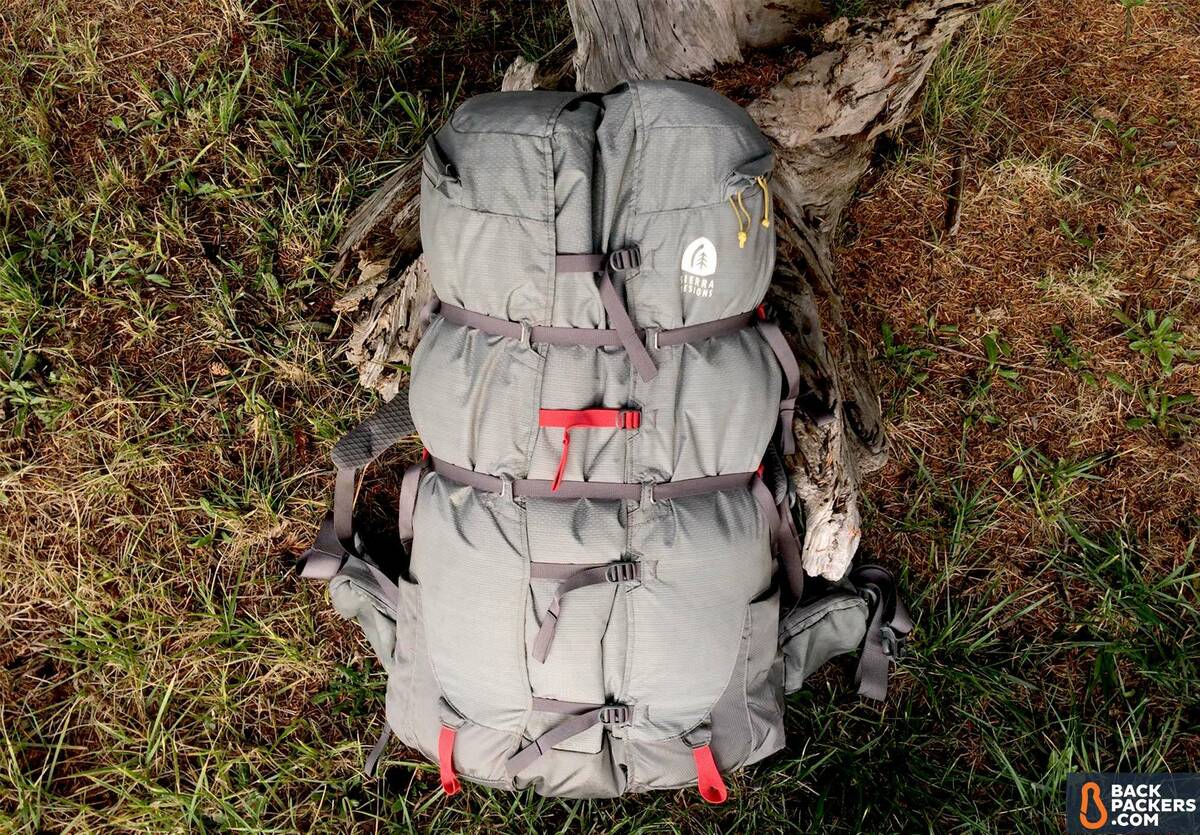


I see that you have your tent attached to the rear of the pack. I’m highly considering purchasing the pack since it’s on sale and wondered if you could have put it inside or was there to much gear. I know, you said it made it less cluttered, but…was there technically enough space? And also curious if you removed your tent poles to get it to fit or were the straps long enough to hold the entire tent. I own a Big Agnes Copper Spur UL2 tent which may require me to put my poles elsewhere.
Hi Jan. I could have fit the tent inside of the bag, but at the time I found it more convenient to strap it onto the outside, especially for the start of this trip when I had a full food supply. I did not need to remove the tent poles, either. The straps are quite long, and the inside is surprisingly cavernous. I don’t think you’ll have any issues fitting your Big Agnes tent inside of the bag. I still highly recommend this backpack and use it to this day! Happy hiking!
WILL IT FIT A BEAR CANISTER SIDEWAYS SAY THE BV 500
It sure can!
I will hike the JMT on September, do you think the flex capacitor 40-60 fits a bear canister, tent, sleeping bag inside? Thanks
Hey there.
You can absolutely make it work. The Flex Capacitor opens up wide enough to fit a BV500 bear can sideways. If you can make all of your gear fit inside depends upon the sizes of your sleeping bag and tent. In this review didn’t use a bear can, but I did carry 5 days worth of food along with all of my usual gear. I opted to strap the tent on the outside, as I found it to be more convenient, however, the Flex Capacitor did have more room to expand and I could have fit the tent inside if I had wanted to.
thanks for you answer!!!
I’m curious about the sizing, specifically the torso length. Many comment that they’re between sizing and struggle to get a good fir with either size. Yours fits well on your shoulders and waist. What is your torso measurement and which size did you go for? I would also be interested to know measurement from shoulder strap (where it sits on your shoulder) to top of hip belt for comparison to my existing packs.
An OK pack, light but therefore somewhat limited. Just depends how much gear / weight you need to carry.
To me it has a number of design flaws – but then for the weight cant complain too much.
The chest strap system is weak / poorly designed with the abilty to run the strap positioning up and down along a bead sounding great in theory but terrible in practice – way too weak, and in my case this strap pulled off twice ! (canbe re-installed with a bit of effort – but after that comes off all the time! I eventually had it sewn permanently into position.
Also don’t like the lack of a brain (which if course makes it lighter). I like to place my ‘immediate day ‘ needs in an easily accesable top pocket. Each to their own, but I place my loo paper/spade, wallet/park permit, torch, sunscreen etc – all my small gear that I might want at different times of the day – and dont want to be hidden somewhere inside my pack – in this pocket. It was so inconvenient NOT having the ‘brain’ (to me) that I purchase an aftermarket pocket to add to the pack. I used the pack on a 7 day winter trek (some snow /ice) in Tasmania. It was OK but with need for winter gear it probably exceeded the ideal capacity – I was
carrying around 22 kg or 48 lb (only 1 litre water luckily). The pack wasnt horrible, but the limited padding was not brilliant … thinking back to heavier , more solid/ padded packs I have used. Another issue is too many straps and bits hanging off, just annoying really. Hip belt pockets also very flimsy – ok for carrying lollies – not much else My conclusion – this pack is good with l light loads and the price is good, so just use it for day or light overnight trips.
Would I recommend ? … probably better options on the market.